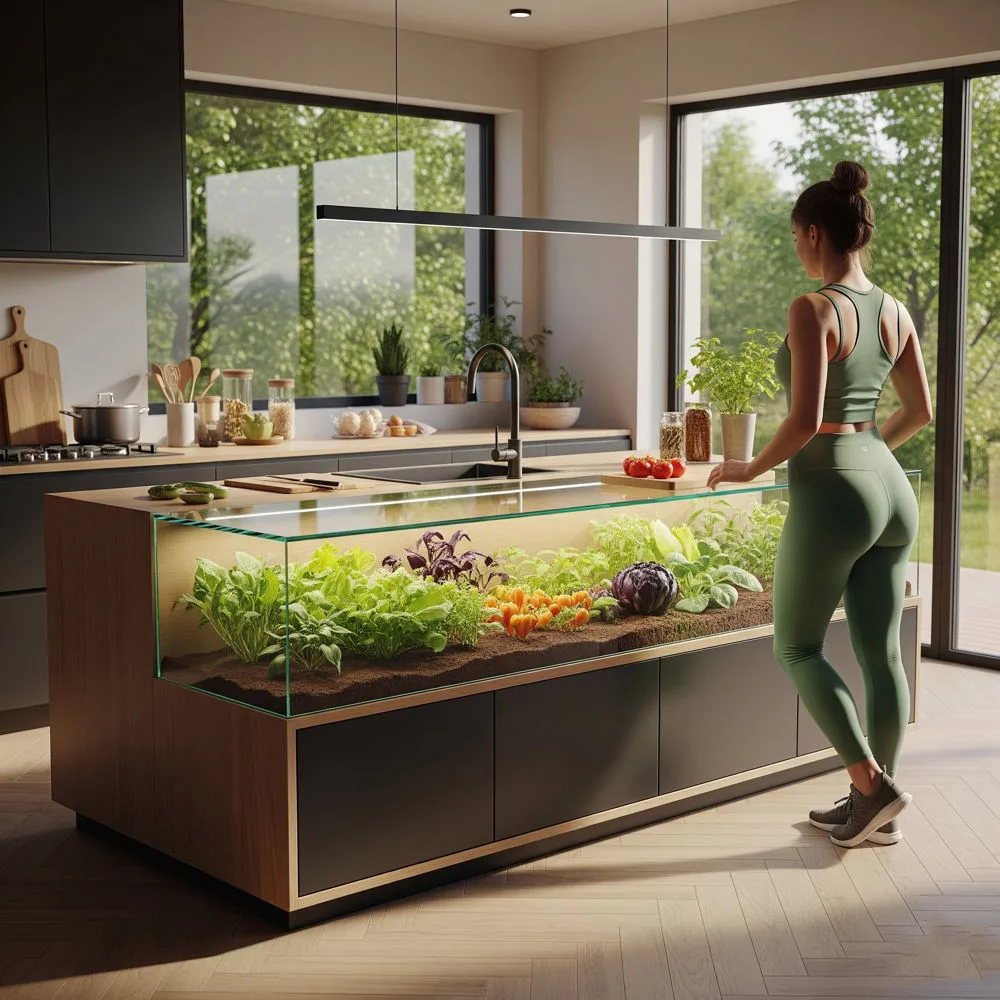What Are Kitchen Islands With Built-in Hydroponic Gardens?
Kitchen islands with built-in hydroponic gardens represent the perfect marriage of culinary functionality and sustainable living. These innovative kitchen centerpieces combine traditional storage and preparation space with integrated growing systems that produce fresh herbs, leafy greens, and small vegetables year-round. Unlike conventional kitchen islands that serve solely as workspace and storage, these revolutionary designs incorporate water-based growing systems that eliminate the need for soil while maximizing growing efficiency.
The concept transforms your kitchen island from a simple piece of furniture into a living, breathing ecosystem that continuously produces fresh ingredients for your meals. These systems typically feature LED grow lights, automated watering systems, and climate control mechanisms that create optimal growing conditions regardless of your home’s natural lighting or seasonal changes.
Modern kitchen islands with built-in hydroponic gardens come in various configurations, from simple herb gardens integrated into the countertop to elaborate multi-tier growing systems that can accommodate dozens of plants simultaneously. The technology behind these systems has evolved dramatically, making them accessible to home cooks who want fresh ingredients without the complexity of traditional gardening.
The Science Behind Hydroponic Kitchen Islands
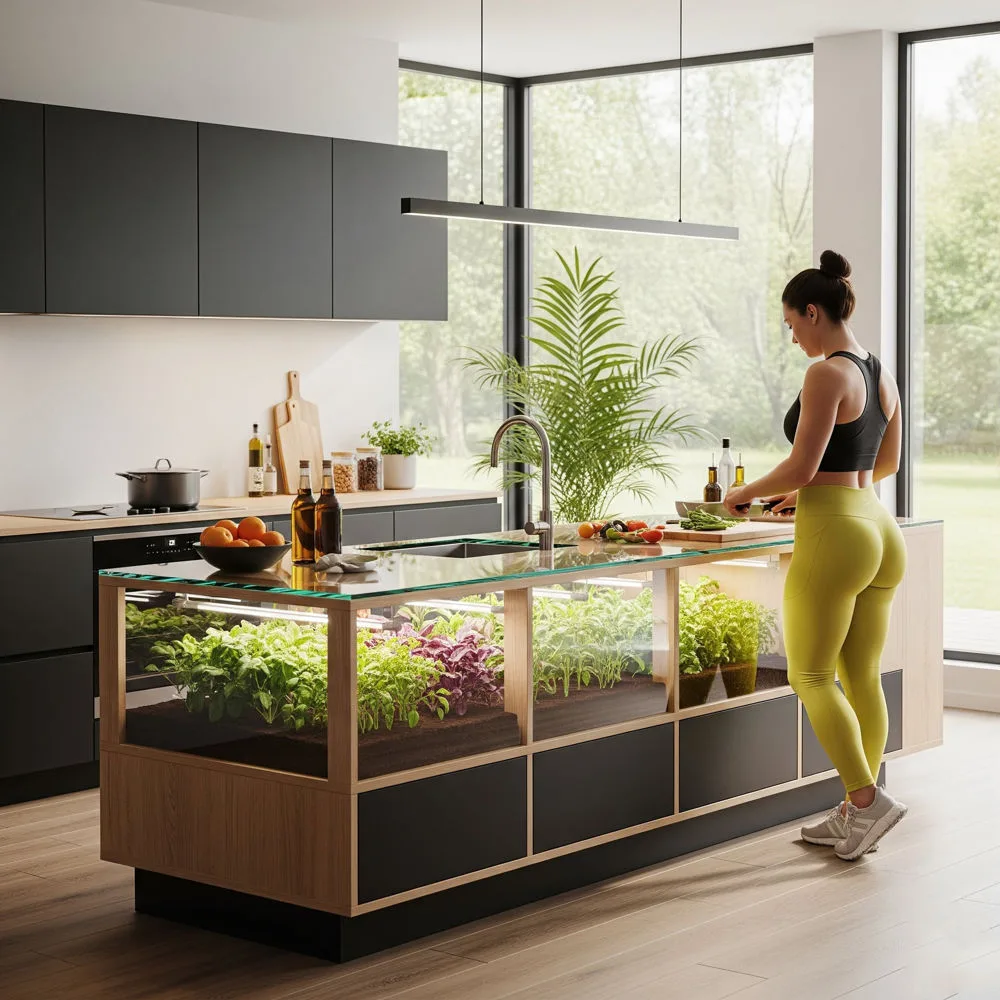
How Hydroponic Systems Work in Kitchen Settings
Hydroponic growing systems operate on the principle of delivering nutrients directly to plant roots through water solutions, eliminating the need for traditional soil. In kitchen islands with built-in hydroponic gardens, this process is carefully controlled through automated systems that monitor pH levels, nutrient concentrations, and water circulation patterns.
The most common hydroponic methods used in kitchen islands include Deep Water Culture (DWC), where plant roots are suspended in nutrient-rich water, and Nutrient Film Technique (NFT), which involves a thin film of nutrient solution flowing continuously over the roots. These systems are particularly well-suited for kitchen environments because they produce minimal mess and can be easily integrated into existing kitchen designs.
Essential Components of Hydroponic Kitchen Islands
Every effective hydroponic kitchen island requires several key components working in harmony. The growing medium, typically consisting of clay pebbles, rockwool, or coconut coir, provides support for plant roots while allowing proper drainage and aeration. The nutrient reservoir stores the water and fertilizer solution that feeds your plants, while the pump system ensures consistent circulation throughout the growing area.
LED grow lights are perhaps the most crucial component, providing the specific light spectrum plants need for photosynthesis. Modern LED systems are energy-efficient and can be programmed to provide different light cycles for various plant types. The control system, often smartphone-compatible, monitors and adjusts environmental conditions automatically, making it possible for even novice gardeners to achieve professional results.
Benefits of Installing Kitchen Islands With Built-in Hydroponic Gardens
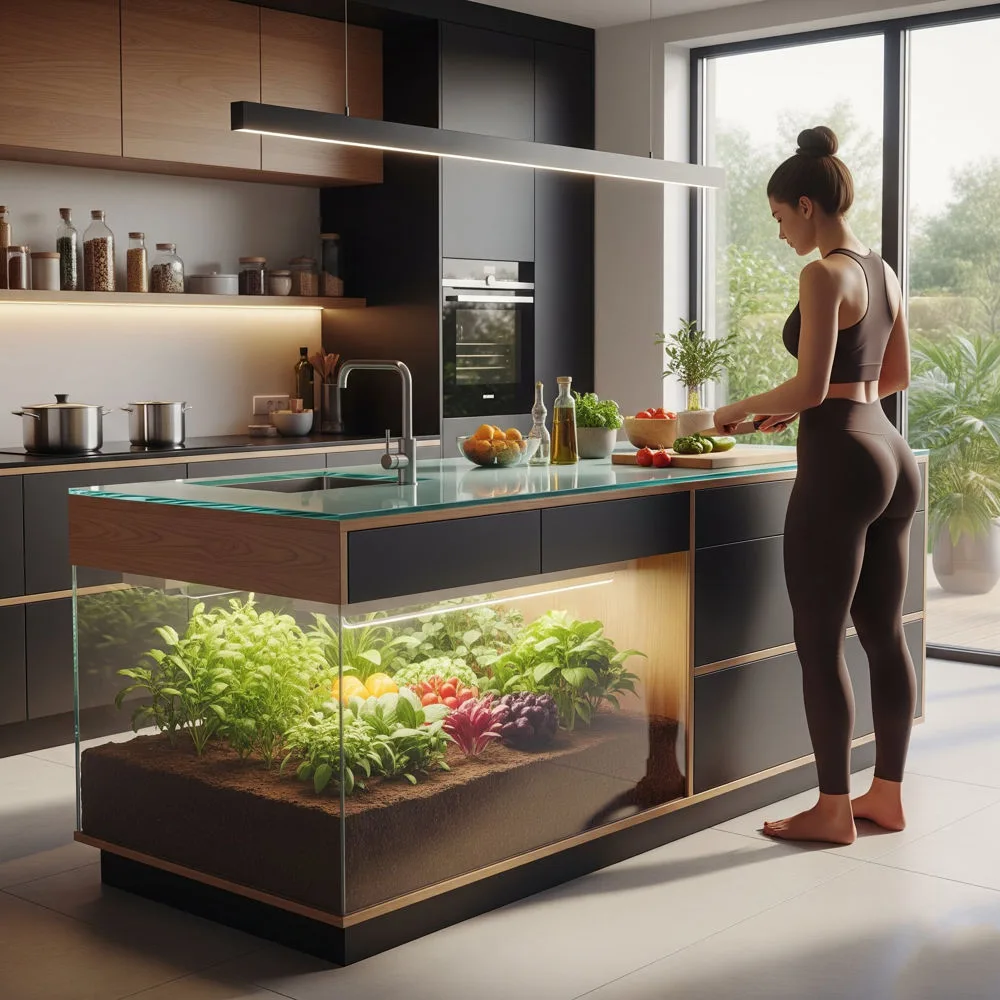
Culinary Advantages
The most immediate benefit of kitchen islands with built-in hydroponic gardens is the constant access to incredibly fresh ingredients. Herbs like basil, cilantro, and parsley can be harvested moments before use, ensuring maximum flavor and nutritional value. This freshness is impossible to achieve with store-bought herbs, which often lose significant flavor and nutrients during transportation and storage.
These systems also enable home cooks to experiment with exotic or hard-to-find varieties that may not be available in local grocery stores. Specialty herbs like purple basil, lemon thyme, or micro greens can be grown easily, expanding your culinary horizons without the premium prices typically associated with these ingredients.
Environmental and Economic Benefits
Kitchen islands with built-in hydroponic gardens significantly reduce your carbon footprint by eliminating the transportation and packaging associated with store-bought produce. The water-efficient nature of hydroponic systems uses up to 90% less water than traditional gardening methods, making them an environmentally responsible choice for conscious consumers.
From an economic perspective, these systems pay for themselves over time through reduced grocery bills. A single basil plant can produce enough leaves for dozens of meals, while store-bought basil packages often cost several dollars and last only a few days. The initial investment in a hydroponic kitchen island is offset by years of fresh produce production.
Health and Wellness Benefits
Growing your own food ensures complete control over what goes into your body. Kitchen islands with built-in hydroponic gardens eliminate concerns about pesticides, herbicides, or other chemicals commonly used in commercial agriculture. You know exactly what nutrients your plants receive and can ensure they’re grown in the cleanest possible environment.
The act of tending to plants also provides psychological benefits, reducing stress and creating a sense of accomplishment. Many homeowners report that their hydroponic kitchen islands become a source of daily joy and meditation, transforming routine cooking into a more mindful, connected experience.
Design Considerations for Hydroponic Kitchen Islands

Size and Scale Planning
When designing kitchen islands with built-in hydroponic gardens, size considerations are paramount. The island must accommodate both traditional kitchen functions and the hydroponic growing system without compromising either. Most successful installations require islands that are at least 6 feet long and 4 feet wide to provide adequate space for both food preparation and plant growing areas.
The growing area should be positioned to receive optimal artificial lighting while remaining easily accessible for daily maintenance and harvesting. Consider the mature size of plants you intend to grow, as some vegetables require significantly more space than herbs. Planning for future expansion or modification is also wise, as many homeowners find themselves wanting to increase their growing capacity once they experience the benefits firsthand.
Integration with Kitchen Aesthetics
Modern kitchen islands with built-in hydroponic gardens can be seamlessly integrated into virtually any kitchen design style. Sleek, minimalist designs work well with contemporary kitchens, while more elaborate systems with visible growing areas can become stunning focal points in traditional or farmhouse-style kitchens.
The key to successful integration is choosing materials and finishes that complement your existing kitchen elements. Stainless steel components work well in modern kitchens, while wooden accents can soften the technological aspects for more traditional spaces. LED lighting can be programmed to provide both functional plant lighting and ambient kitchen illumination.
Lighting Design Strategies
Proper lighting design is crucial for both plant health and kitchen aesthetics. Full-spectrum LED grow lights should be positioned to provide even coverage across the entire growing area while minimizing glare in the kitchen workspace. Many systems incorporate adjustable light heights to accommodate plants as they grow.
Consider incorporating timer systems that align plant lighting with your daily routines. Some homeowners prefer subtle grow lights that operate continuously, while others enjoy the dramatic effect of bright growing lights that can be dimmed or turned off during meal preparation and entertaining.
Popular Plants for Hydroponic Kitchen Islands
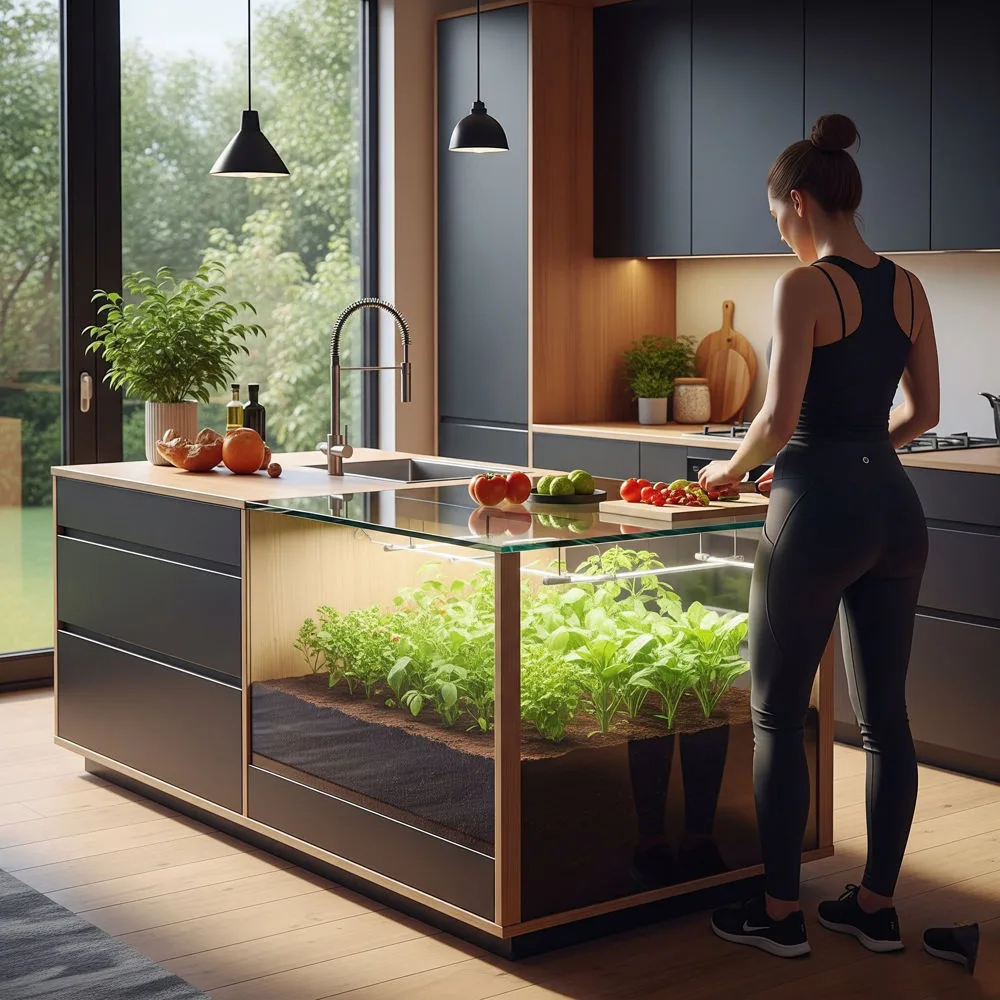
Herbs and Leafy Greens
Herbs are the most popular choice for kitchen islands with built-in hydroponic gardens due to their compact size, rapid growth, and frequent culinary use. Basil, cilantro, parsley, chives, and mint are excellent starting options that provide immediate culinary benefits and are relatively easy to grow hydroponically.
Leafy greens like lettuce, spinach, arugula, and kale also thrive in hydroponic systems and can provide significant nutritional value. These plants typically have shallow root systems that work well in kitchen island configurations and can be harvested continuously through cut-and-come-again harvesting methods.
Microgreens and Specialty Crops
Microgreens represent an exciting frontier for hydroponic kitchen islands, offering intense flavors and exceptional nutritional density in compact packages. These young plants can be grown in very small spaces and harvested within 10-14 days, making them perfect for impatient gardeners or those wanting quick results from their new system.
Specialty crops like cherry tomatoes, peppers, and even strawberries can be grown in larger hydroponic kitchen islands, though they require more space and specialized care. These crops provide a greater sense of accomplishment and can significantly impact grocery bills, especially for families that consume large quantities of fresh produce.
Installation and Maintenance
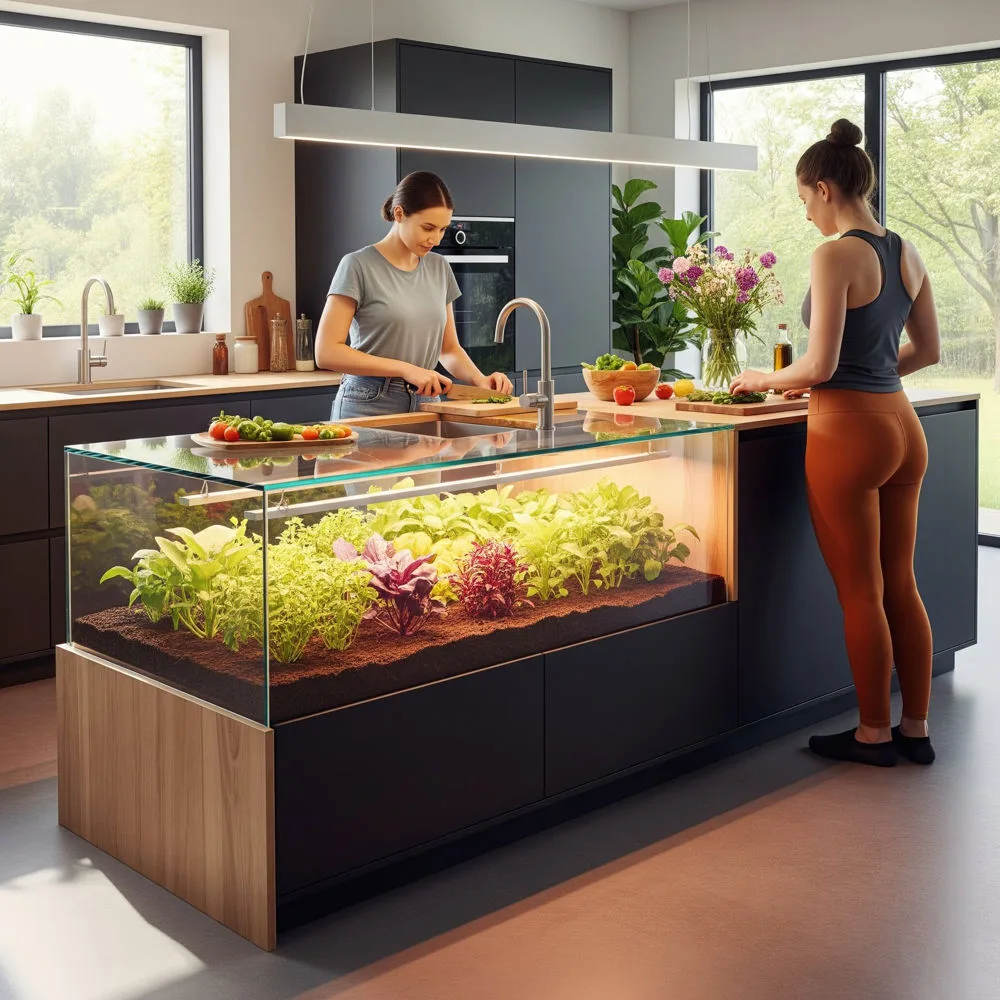
Professional Installation vs DIY Approaches
Kitchen islands with built-in hydroponic gardens can be installed through professional services or as ambitious DIY projects. Professional installation ensures proper integration with existing plumbing, electrical systems, and kitchen layouts, while also providing warranties and ongoing support. This approach is recommended for complex systems or homeowners who prefer turnkey solutions.
DIY installation appeals to handy homeowners who enjoy projects and want to save on labor costs. Many manufacturers now offer complete kits with detailed instructions, making it possible for motivated individuals to install their own systems. However, DIY installation requires careful planning and may void warranties if not executed properly.
Daily and Weekly Maintenance Requirements
Successful hydroponic kitchen islands require consistent but minimal maintenance. Daily tasks include checking water levels, observing plant health, and harvesting mature produce. Most systems include automated monitoring that alerts you to any issues requiring attention.
Weekly maintenance involves cleaning growing surfaces, checking nutrient levels, and pruning plants as needed. Monthly tasks include thorough system cleaning, replacing filters, and rotating plant varieties to maintain soil health and prevent pest buildup. With proper maintenance, these systems can operate efficiently for years with minimal intervention.
Troubleshooting Common Issues
Common issues with hydroponic kitchen islands include algae growth, which can be prevented through proper light management and regular cleaning. Nutrient deficiencies are usually easy to identify through leaf color changes and can be corrected by adjusting nutrient solutions or pH levels.
Pest management in indoor hydroponic systems is generally easier than outdoor gardening, but occasional issues with aphids or fungus gnats may arise. These problems can usually be resolved through beneficial insects, organic treatments, or improved air circulation around the growing area.
Cost Analysis and Investment Considerations
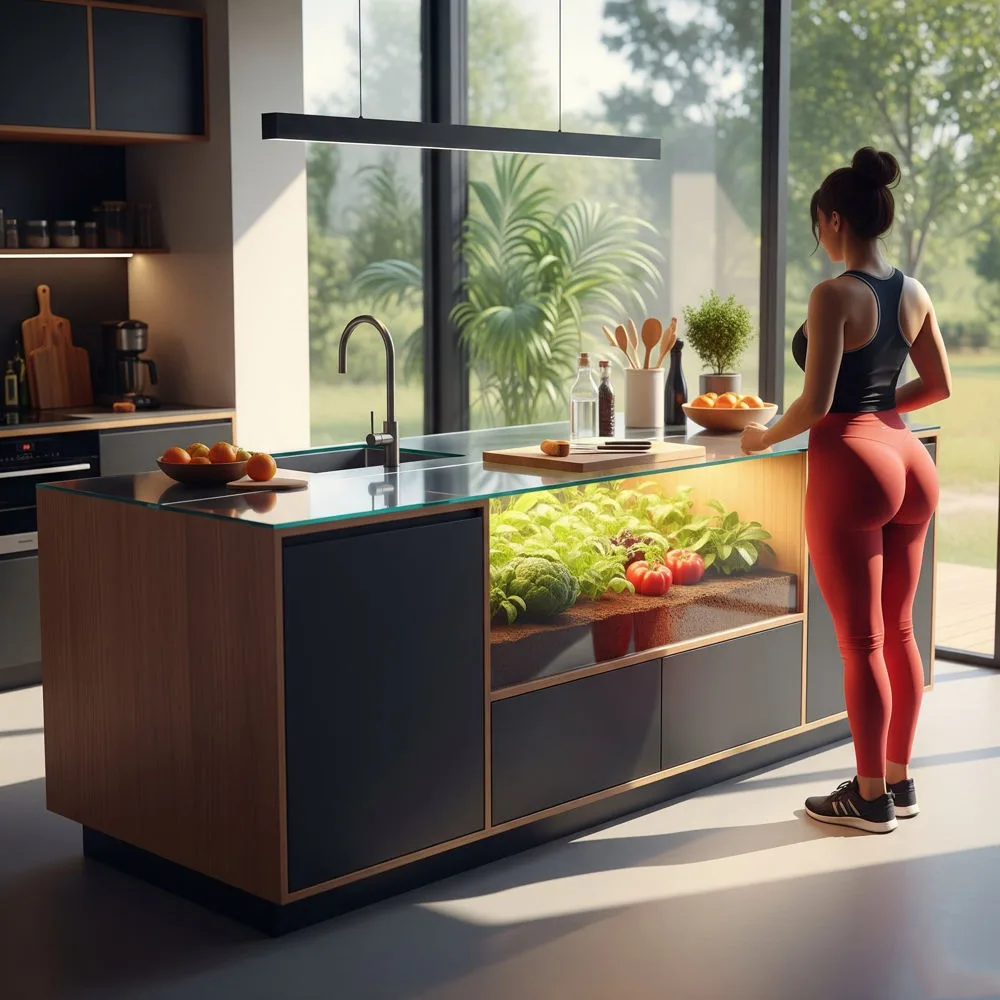
Initial Investment Breakdown
The cost of kitchen islands with built-in hydroponic gardens varies significantly based on size, complexity, and installation method. Basic systems integrated into existing islands can start around $2,000-$3,000, while elaborate custom installations may cost $10,000-$15,000 or more.
Key cost factors include the hydroponic system itself, LED lighting, control systems, and installation labor. Custom cabinetry and high-end finishes can dramatically increase costs, while more basic installations focusing on functionality over aesthetics can be accomplished at the lower end of the price range.
Long-term Economic Benefits
Despite the significant initial investment, kitchen islands with built-in hydroponic gardens can provide substantial long-term economic benefits. Fresh herbs that cost $3-$5 per package in stores can be grown continuously for pennies per serving. A family spending $50-$100 monthly on fresh herbs and greens can recover their investment within 3-5 years through reduced grocery costs.
The economic benefits extend beyond direct food savings to include reduced food waste, since you only harvest what you need when you need it. Additionally, the increased property value associated with unique, sustainable kitchen features can provide additional return on investment for homeowners considering resale value.
Future Trends and Innovations
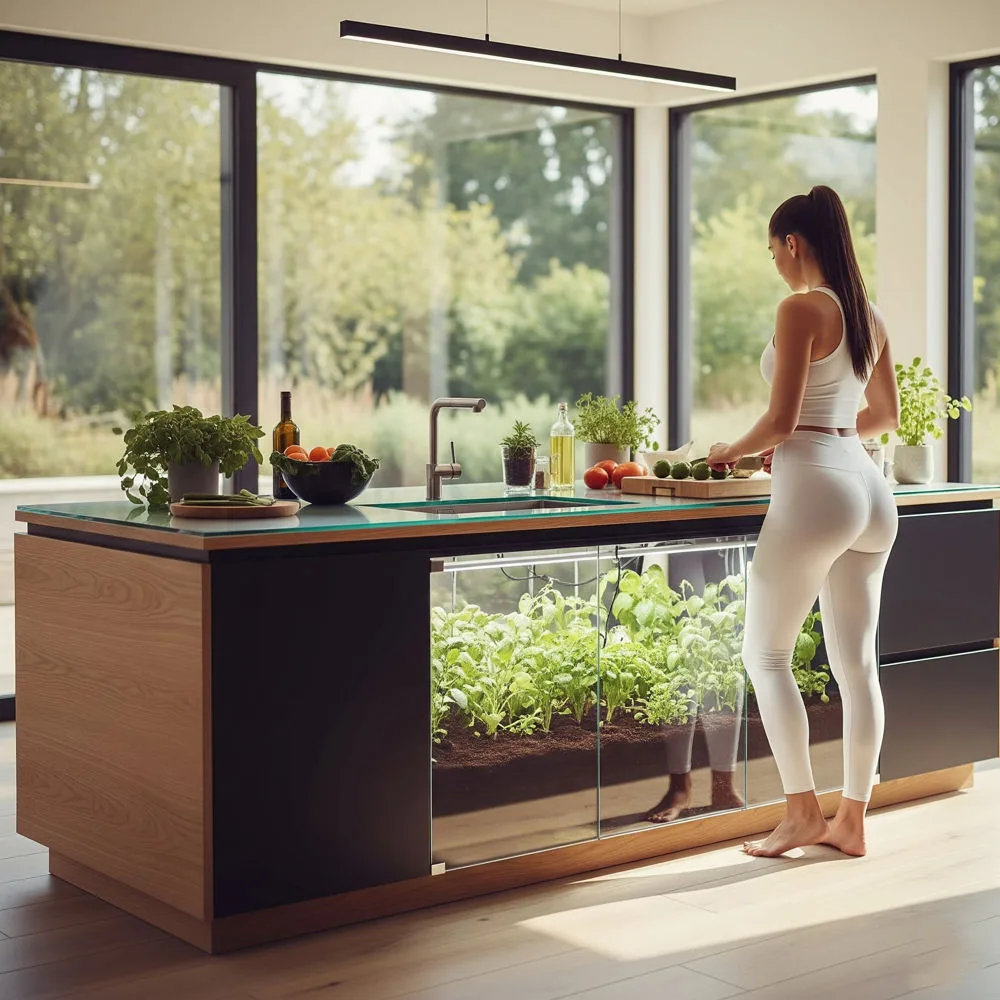
Smart Technology Integration
The future of kitchen islands with built-in hydroponic gardens lies in increased smart technology integration. Artificial intelligence systems are being developed that can automatically adjust growing conditions based on plant species, growth stage, and environmental factors. These systems will make hydroponic gardening even more accessible to novice gardeners while maximizing yields for experienced growers.
Smartphone integration is becoming increasingly sophisticated, allowing homeowners to monitor and control their systems remotely. Future developments may include automated harvesting systems, integrated pest detection, and even AI-powered recipe suggestions based on available produce.
Sustainable Materials and Energy Efficiency
Future innovations in kitchen islands with built-in hydroponic gardens will focus heavily on sustainability and energy efficiency. Solar-powered systems, recycled materials, and energy-efficient LED lighting will become standard features as manufacturers respond to growing environmental consciousness among consumers.
Water recycling systems and closed-loop nutrient management will further reduce environmental impact while minimizing operating costs. These advances will make hydroponic kitchen islands even more attractive to environmentally conscious homeowners seeking sustainable living solutions.
Conclusion
Kitchen islands with built-in hydroponic gardens represent a revolutionary approach to home cooking that combines convenience, sustainability, and culinary excellence in a single, elegant solution. These innovative systems transform ordinary kitchens into productive growing spaces that provide fresh, nutritious ingredients year-round while reducing environmental impact and grocery costs.
The technology behind these systems has matured to the point where they’re accessible to homeowners of all skill levels, from complete beginners to experienced gardeners. With proper planning, installation, and maintenance, a hydroponic kitchen island can provide years of fresh produce, culinary inspiration, and personal satisfaction.
As we move toward a more sustainable future, kitchen islands with built-in hydroponic gardens offer a practical way for homeowners to reduce their environmental footprint while enjoying the freshest possible ingredients. Whether you’re a passionate cook seeking ultimate ingredient quality or an environmentally conscious homeowner looking to grow your own food, these systems provide an elegant solution that enhances both your kitchen’s functionality and your family’s well-being.
The investment in a hydroponic kitchen island extends far beyond the initial cost, providing ongoing benefits that improve your cooking, health, and connection to the food you eat. As technology continues to advance and costs decrease, these systems will become increasingly common in homes worldwide, representing the future of sustainable, convenient home food production.

